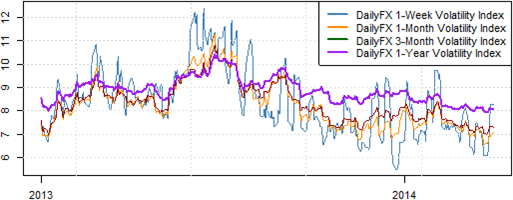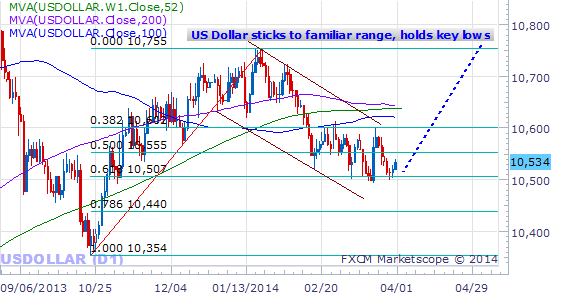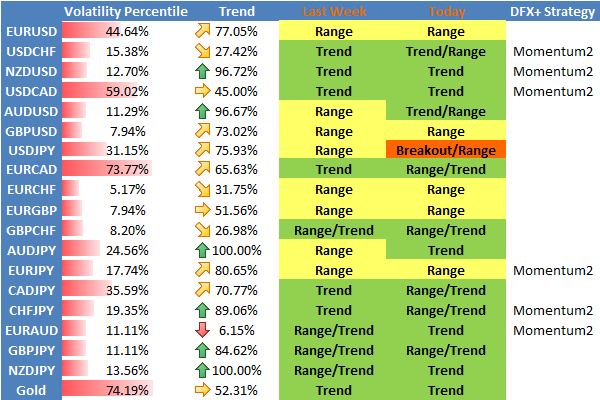Dollar Lining up for Major Moves as key Factors Favor Reversal
- US Dollar at major cyclical turning point, is strength ahead?
- A spike in forex volatility prices favors bigger moves in the days to come
- We’ll keep a close eye on the Dollar Index in particular as it bounces off key lows
The US Dollar continues to trade within a familiar trading range, but the coming week promises big currency moves. Why might this finally bring the Dollar break?
The beginning of the new week, month, and calendar quarter is a critical time for major financial asset prices. Why? Put simply, currencies and other assets are considerably more likely to establish new trends and trend reversals at the beginning of new calendar periods.
We can see this on a daily, weekly, monthly, quarterly, and yearly basis. As might be expected, the change of quarter and year is considerably more important than month, week, day, and so on.
Short-term FX volatility prices have likewise surged ahead of what promises to be a big week for economic event risk, and this in turn adds further weight to our argument for an important US Dollar reversal.
Short-term Forex Volatility Prices Jump Ahead of Critical week for US Dollar

Source: OTC FX Options Prices from Bloomberg; DailyFX Calculations
We’ll pay special attention to the trading range in the Dow Jones FXCM Dollar Index, as a hold of key lows suggests that the cyclical turn window may coincide with an important US Dollar bottom.
Cyclical Turn Window Lines up with Dollar Bounce off of Key Lows

Source: FXCM Trading Station Desktop, Prepared by David Rodriguez
From an automated trading strategy perspective, our outlook for trends leave us in somewhat of a “wait and see” mode. In short: we generally want to be positioned for Dollar strength, but markets likewise need to show themselves willing to push the Greenback strongly off of lows.
We’ll keep a close eye on US Dollar pairs in the week ahead. Sign up for future e-mail updates via my distribution list.
DailyFX Individual Currency Pair Conditions and Trading Strategy Bias


Automate our SSI-based trading strategies via Mirror Trader free of charge
--- Written by David Rodriguez, Quantitative Strategist for DailyFX.com
To receive the Speculative Sentiment Index and other reports from this author via e-mail, sign up to David’s e-mail distribution list via this link.
Contact David via Twitter at http://www.twitter.com/DRodriguezFX
Definitions
Volatility Percentile – The higher the number, the more likely we are to see strong movements in price. This number tells us where current implied volatility levels stand in relation to the past 90 days of trading. We have found that implied volatilities tend to remain very high or very low for extended periods of time. As such, it is helpful to know where the current implied volatility level stands in relation to its medium-term range.
Trend – This indicator measures trend intensity by telling us where price stands in relation to its 90 trading-day range. A very low number tells us that price is currently at or near 90-day lows, while a higher number tells us that we are near the highs. A value at or near 50 percent tells us that we are at the middle of the currency pair’s 90-day range.
Range High – 90-day closing high.
Range Low – 90-day closing low.
Last – Current market price.
Bias – Based on the above criteria, we assign the more likely profitable strategy for any given currency pair. A highly volatile currency pair (Volatility Percentile very high) suggests that we should look to use Breakout strategies. More moderate volatility levels and strong Trend values make Momentum trades more attractive, while the lowest Vol Percentile and Trend indicator figures make Range Trading the more attractive strategy.
HYPOTHETICAL PERFORMANCE RESULTS HAVE MANY INHERENT LIMITATIONS, SOME OF WHICH ARE DESCRIBED BELOW. NO REPRESENTATION IS BEING MADE THAT ANY ACCOUNT WILL OR IS LIKELY TO ACHIEVE PROFITS OR LOSSES SIMILAR TO THOSE SHOWN. IN FACT, THERE ARE FREQUENTLY SHARP DIFFERENCES BETWEEN HYPOTHETICAL PERFORMANCE RESULTS AND THE ACTUAL RESULTS SUBSEQUENTLY ACHIEVED BY ANY PARTICULAR TRADING PROGRAM.
ONE OF THE LIMITATIONS OF HYPOTHETICAL PERFORMANCE RESULTS IS THAT THEY ARE GENERALLY PREPARED WITH THE BENEFIT OF HINDSIGHT. IN ADDITION, HYPOTHETICAL TRADING DOES NOT INVOLVE FINANCIAL RISK, AND NO HYPOTHETICAL TRADING RECORD CAN COMPLETELY ACCOUNT FOR THE IMPACT OF FINANCIAL RISK IN ACTUAL TRADING. FOR EXAMPLE, THE ABILITY TO WITHSTAND LOSSES OR TO ADHERE TO A PARTICULAR TRADING PROGRAM IN SPITE OF TRADING LOSSES IS MATERIAL POINTS WHICH CAN ALSO ADVERSELY AFFECT ACTUAL TRADING RESULTS. THERE ARE NUMEROUS OTHER FACTORS RELATED TO THE MARKETS IN GENERAL OR TO THE IMPLEMENTATION.
OF ANY SPECIFIC TRADING PROGRAM WHICH CANNOT BE FULLY ACCOUNTED FOR IN THE PREPARATION OF HYPOTHETICAL PERFORMANCE RESULTS AND ALL OF WHICH CAN ADVERSELY AFFECT ACTUAL TRADING RESULTS. Any opinions, news, research, analyses, prices, or other information contained on this website is provided as general market commentary, and does not constitute investment advice. The FXCM group will not accept liability for any loss or damage, including without limitation to, any loss of profit, which may arise directly or indirectly from use of or reliance contained in the trading signals, or in any accompanying chart analyses.
original source






 Indonesia
Indonesia